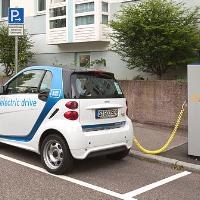(BRUSSELS) – The EU’s Parliament and Council reached political agreement Tuesday to boost the number of publicly accessible electric recharging and hydrogen refuelling stations.
Transport was responsible for about a quarter of the EU’s total CO2 emissions in 2019, of which 71.7% came from road transportation, according to the European Environment Agency.
This landmark agreement will enable the transition to zero-emission transport and contribute to the EU’s target of reducing net greenhouse gas emissions by at least 55% by 2030.
The new Regulation for the deployment of alternative fuels infrastructure (AFIR) sets mandatory deployment targets for electric recharging and hydrogen refuelling infrastructure for the road sector, for shore-side electricity supply in maritime and inland waterway ports, and for electricity supply to stationary aircraft. By making a minimum of recharging and refuelling infrastructure available across the EU the regulation will end consumer concerns about the difficulty to recharge or refuel a vehicle. AFIR also paves the way for a user-friendly recharging and refuelling experience, with full price transparency, common minimum payment options and coherent customer information across the EU.
The new AFIR rules will ensure sufficient and user-friendly alternative fuels infrastructure for road, shipping and aviation. This will enable the use of zero-emission road vehicles, in particular electric and hydrogen light- and heavy-duty vehicles, as well as electricity supply to moored vessels and stationary aircraft. Specifically, the following main deployment targets will have to be met in 2025 or 2030:
- Recharging infrastructure for cars and vans has to grow at the same pace as vehicle uptake. To that end, for each registered battery-electric car in a given Member State, a power output of 1.3 kW must be provided by publicly accessible recharging infrastructure. In addition, every 60 km along the trans-European transport (TEN-T) network, fast recharging stations of at least 150 kW need to be installed from 2025 onwards.
- Recharging stations dedicated to heavy-duty vehicles with a minimum output of 350 kW need to be deployed every 60 km along the TEN-T core network, and every 100 km on the larger TEN-T comprehensive network from 2025 onwards, with complete network coverage to be achieved by 2030. In addition, recharging stations must be installed at safe and secure parking areas for overnight recharging as well as in urban nodes for delivery vehicles.
- Hydrogen refuelling infrastructure that can serve both cars and lorries must be deployed from 2030 onwards in all urban nodes and every 200 km along the TEN-T core network, ensuring a sufficiently dense network to allow hydrogen vehicles to travel across the EU.
- Maritime ports that see at least 50 port calls by large passenger vessels, or 100 port calls by container vessels, must provide shore-side electricity for such vessels by 2030. This will not only help reduce the carbon footprint of maritime transport, but also significantly reduce local air pollution in port areas.
- Airports must provide electricity to stationary aircraft at all contact stands (gates) by 2025, and at all remote stands (outfield positions) by 2030.
- Operators of electric recharging and hydrogen refueling stations must ensure full price transparency, offer a common ad hoc payment method such as debit or credit card, and make relevant data, such as that on location, available through electronic means, thereby ensuring the customer is fully informed.
The political agreement now needs to be formally adopted. Once this process is completed by the European Parliament and the Council, the new rules will be published in the Official Journal of the European Union and enter into force after a transitional period of 6 months.
Official Journal and enter into force on the twentieth day following that of its publication.
Further information, European Parliament
Procedure file on alternative fuels infrastructure (AFIR)
EP Research Service overview of alternative fuels infrastructure (March 2023)



